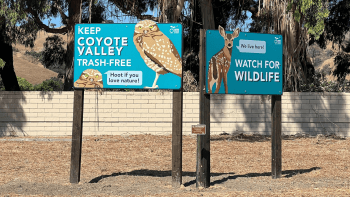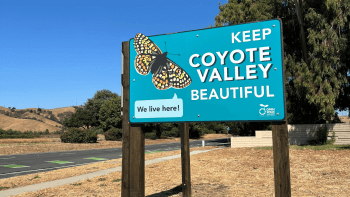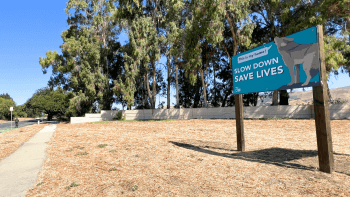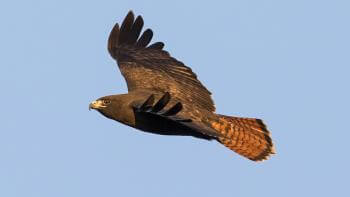A Sure Sign of Conservation
Situated along fields of open space that make up the Coyote Valley landscape, stand a new series of placemaking and educational signs from the Santa Clara Valley Open Space Authority. These monumental signs are both a physical designation of the Coyote Valley Conservation Program Area, as well as a symbol of the Authority’s ongoing efforts to conserve natural and working lands and protect wildlife in the region.

Installation of these signs took place during the summer of 2025, replacing former “Don’t Trash Coyote Valley” signage on the corner of Bailey Avenue and Santa Teresa Boulevard. The new placemaking signs sit on either end of Coyote Valley, bookending the over 1,500 acres of land that is now protected on the valley floor.
These lands, significant in size and purpose, offer increased habitat for local wildlife by connecting 1.1 million acres of habitat between the Santa Cruz Mountains and Diablo Range, protect Santa Clara Valley residents from extreme weather and provide local farmers with agricultural land to grow their crops. While these placemaking signs represent the Open Space Authority’s successful land conservation efforts of the past, they’re also indicative of the work that lies ahead.
The future health and resilience of our region hinges on protecting and restoring places like Coyote Valley. Thousands of people drive along Santa Teresa Boulevard every day, and we hope these signs help raise awareness that the beautiful fields and farmlands they pass by are part of an important conservation vision.
In the future, the Open Space Authority plans to restore habitat, and open parts of the preserved Coyote Valley landscape as a place where people can come to enjoy nature and local agriculture for recreational use. Through the Coyote Valley Conservation Areas Master Plan (CVCAMP), the name for the Open Space Authority’s in-progress planning project in the Coyote Valley area, public feedback and participation will help inform the best ways to utilize and enhance the land as planning continues to take shape.

One way the CVCAMP planning team hopes to improve the Coyote Valley landscape is to make it safer for wildlife to roam their native habitat. To honor this important initiative, the Open Space Authority installed a second set of signs in Coyote Valley that serve as physical reminders that sensitive species live there too.
Much like the former “Don’t Trash Coyote Valley” signage, the Open Space Authority hopes this new set of wildlife signage will encourage the public to dispose of their trash and construction debris in an appropriate manner. Often, illegal dumping plagues the sides of the roads in Coyote Valley, endangering the health of local wildlife and causing negative environmental impacts. Coyotes, for example, are an important part of the region's ecosystem, but may ingest discarded trash or chemicals found on the side of the road which can be deadly.

Additionally, the new wildlife signs shed light on the need for drivers to “Watch for Wildlife,” and “Slow Down, Save Lives.” Species such as mountain lions and bobcats cross the roads in Coyote Valley with the desire to migrate to new areas and shift ranges, preserving biodiversity and genetically healthy populations. These new signs serve as physical reminders to drivers that watching the road can help protect wildlife while also emphasizing the need for safe wildlife crossings in the area.

Installation of the placemaking and wildlife signs is also another way for the Open Space Authority to highlight the importance of preserving Coyote Valley.
The signs, designed by Annamarie Pilon, the Open Space Authority’s Multimedia Communications Specialist, were inspired by Coyote Valley’s abundant benefits including its scenic rolling hills, prosperous agriculture and easily accessible nature for Santa Clara Valley residents.
"It's exciting to see more and more people recognize and appreciate Coyote Valley for its environmental benefits, beauty and importance. We're hopeful that these signs not only increase public awareness of the landscape but also add to the experience of driving through Coyote Valley on the way to work, home, school or travels."
The next time you’re traveling through Coyote Valley, keep an eye out for these new signs that dot the roadway and signify the ongoing conservation efforts of the Open Space Authority. Thanks to public support, the Authority will continue to provide increased access to natural areas for both the public and wildlife to enjoy for many years to come.



